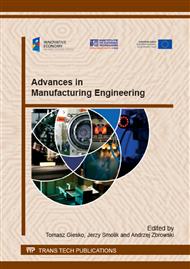[1]
J. Gawlik, M. Niemczewska-Wójcik, J. Krajewska, Technological systems of shaping elements out of difficult to-machine materials, Oficyna Wydawnicza Polskiego Towarzystwa Zarządzania Produkcją w Opolu, Opole 2014, s. 723-735.
Google Scholar
[2]
A. Boratyńska-Sala, J. Krajewska, Innowacyjne zarządzanie firmą z wykorzystaniem TRIZ: Inżynieria Innowacji, Zarządzanie operacyjne w teorii i praktyce organizacji biznesowych, publicznych i pozarządowych, Wałbrzyska Wyższa Szkoła Zarządzania i Przedsiębiorczości, Wałbrzych (2013).
Google Scholar
[3]
Z. Weiss (red. ), Virtual Design and Automation. Wyd. Politechniki Poznańskiej, Poznań, 2005, p.35.
Google Scholar
[4]
K. Unger, Manufacturers' Needs Not Changing – But Acronyms Are. Industrial Computing, International Society of Automation, 11, 2001, pp.46-48.
Google Scholar
[5]
J. Gawlik, A. Kiełbus, D. Karpisz, Problematyka gromadzenia wiedzy o precyzyjnej obróbce materiałów o specjalnych właściwościach, XVI Konferencja- Innowacje w Zarządzaniu I Inżynierii Produkcji, Oficyna Wydawnicza Polskiego Towarzystwa Zarządzania Produkcją, Opole 2013, s. 1146-1157.
Google Scholar
[6]
C. Karlsoon, P. Ahlstrom, Assessing Changes toward Lean Production. Journal of Operations and Production Management, 16, 2, 1996, pp.24-41.
Google Scholar
[7]
C.R. Duguay, S. Landry, F. Pasin, From Mass Production to Flexible/Agile Production. Journal of Operations and Production Management, 1997, 17, 12, pp.1183-1195.
DOI: 10.1108/01443579710182936
Google Scholar
[8]
F.T.S. Chana, H.C.W. Laub, R.W.L. Ipc, H.K. Chana, S. Konga, Implementation of total productive maintenance: A case study. International Journal of Production Economics, Vol 95, Issue 1, 28, 2005, p.71–94.
Google Scholar
[9]
B. Al-Najjara, I. Alsyoufb, Selecting the most efficient maintenance approach using fuzzy multiple criteria decision making. International Journal of Production Economics, Vol. 84, Issue 1, 11, 2003, p.85–100.
DOI: 10.1016/s0925-5273(02)00380-8
Google Scholar
[10]
T. Wireman, Total Productive Maintenance. Industrial Press Inc., 2005, pp.129-141.
Google Scholar
[11]
J. Gawlik, A. Kiełbus, Komputerowo wspomagana analiza jakości wyrobów na przykładzie maszyn technologicznych. Komputerowo Zintegrowane Zarządzanie, Oficyna wydawnicza PTZP, Opole, 2009, s. 324-333.
Google Scholar
[12]
R. Knosala, Zastosowanie metod sztucznej inteligencji w inżynierii produkcji, WNT, Warszawa, (2002).
Google Scholar
[13]
O.K. Kverneland, Metric standards for worldwide manufacturing. ASME Press, (2007).
Google Scholar
[14]
W.A. Khan, A. Raouf, Standards for engineering design and manufacturing. CRC/Taylor& Francis, (2006).
Google Scholar
[15]
F. Golshani, Y. Park, Perspective: A Standards-Based System for Manufacturing Information Integration. Journal of Intelligent and Robotic Systems, 1999, Volume 26, Issue 3-4, pp.231-247.
Google Scholar
[16]
SCRA, Step Application Handbook ISO 10303 version 3. SCRA, (2006).
Google Scholar
[17]
J. Gawlik, A. Kiełbus, D. Karpisz, DBSMP - the new approach to integrated data management in special materials processing, Advances in Manufacturing Science and Technology, Oficyna Wydawnicza Politechniki Rzeszowskiej, Rzeszów 2014, pp.23-36.
DOI: 10.2478/amst-2014-0002
Google Scholar
[18]
Shingo S.: Revolution in Manufacturing: Single-minute Exchange of Die System. Productivity Press, (1985).
Google Scholar
[19]
J. Gawlik, A. Kiełbus, Zastosowania metod sztucznej inteligencji w nadzorowaniu urządzeń technologicznych i jakości wyrobów. Praktyka zarządzania jakością w XXI wieku. (monografia pod red. Tadeusza Sikory i Mariusza Giemzy). Wydawnictwo Naukowe PTTŻ, Kraków 2012, ISBN 978-83-929209-7-7, s. 508-534.
Google Scholar
[20]
D. Karpisz, Nie tylko relacyjny model danych, Czasopismo Techniczne, Nr 7 (108), 2011, pp.187-194.
Google Scholar
[21]
E.F. Codd, A relational model of data for large shared data banks. Communications of ACM, Vol. 13, No 6, 1970, pp.377-387.
DOI: 10.1145/362384.362685
Google Scholar


